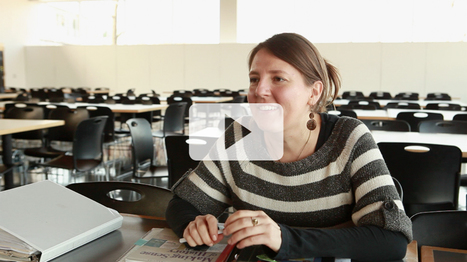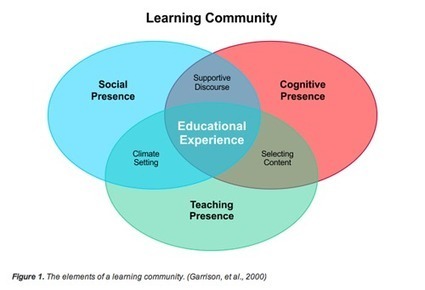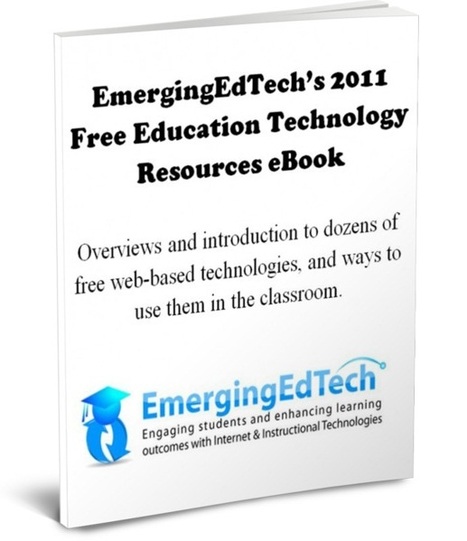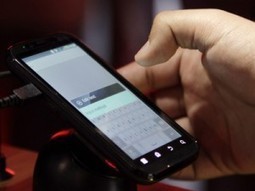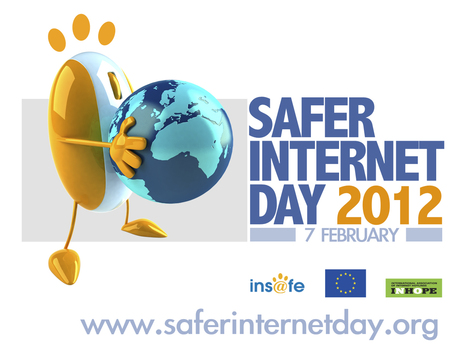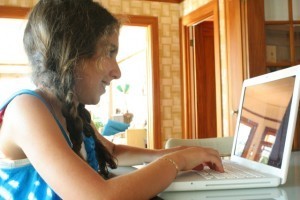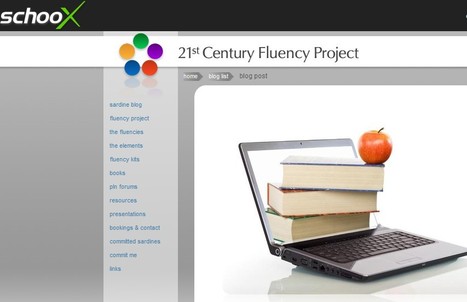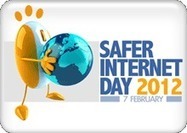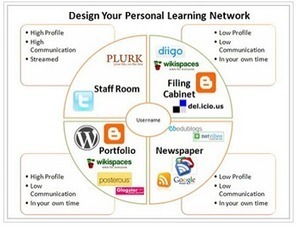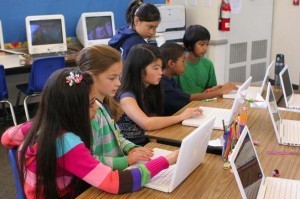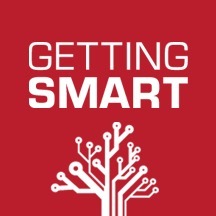What are the elements of a lesson plan to teach students how to think creatively and critically? And how do we measure what they've learned?
Get Started for FREE
Sign up with Facebook Sign up with X
I don't have a Facebook or a X account

 Your new post is loading... Your new post is loading...
 Your new post is loading... Your new post is loading...
Current selected tag: 'Education-Evolution'. Clear
Design Thinking is a mindset. Design Thinking is the confidence that everyone can be part of creating a more desirable future, and a process to take action when faced with a difficult challenge. That kind of optimism is well needed in education.
Gust MEES's insight:
La création de communautés d'apprentissage améliore fortement l'efficacité de l'enseignement à distance, dans la mesure où elle réduit le sentiement d'isolement des apprenants et leur permet de s'appuyer les uns sur les autres.
Knowing the tools for 21st Century Learning is primordial to give quality courses...
Gust MEES: Find out more, but don't forget this; not ONLY tools make a good teacher, your pedagogical knowledge as your general knowledge and your knowledge about 21st century Learning and Teaching is the most important and your way how you communicate!
The "C" in "ICT", "Communication"; these mixed up with engaging and motivating your students (learners) gives you success :)
Did I say "You", sorry: gives success to you and the learners... The learners (students), the MOST important anyway ;-)
Find out more in my article...
These Technologies Are Changing Education. Are You Familiar With Them?
Facts and statistics about online safety.
GM: use this also on schools and together with the parents of your students... Via Clem
Kindergarten inclusion teacher Trisha Riche' inspires her students -- and her readers -- to play, learn and teach outside of the box.
Bodin said there’s no automatic app discovery or tracking software to detect if a user is downloading apps that could be seen as objectionable by managers. IBM, however, has long had in place “very aggressive” business conduct guidelines that should govern the behaviors and personal decisions of users when picking apps.
IBM requires every staffer to sign these business conduct guidelines, but this new policy does provide some room for employees to slack off. Interestingly enough, this has been proven to actually increase productivity by a couple of students at the Academy of Management in Texas.
Next year, Safer Internet Day (SID) will take place on Tuesday 7 February 2012 and will be centred on the theme Connecting generations and educating each other, with the slogan: "Discover the digital world together... safely!"
About Connecting Generations This topic looks at the reach of the online world across all generations and cultures and encourages families to work together to stay safe online. Whether you are 5, 40 or 75 years old, whether you use the internet once a month or several times a day - each person has something different to bring to the table that can help shape our online experiences and our understanding of online competences and safety. We all have a role to play in ensuring that every child is safe online.
Today our offline and online worlds are strongly connected, from families communicating via webcam with relatives and friends abroad to children doing their homework online. The online world is a unique arena where people of all ages can learn together and from each other, especially regarding online safety. Tech savvy youngsters can teach their elders how to use new technologies, while grandparents can draw on their life experiences to advise younger generations on how to stay safe online, as they discover the digital world together.
Anne-Grete Nøhr Elliot (2011) From Preservice Teacher Education to the Primary Classroom: An Investigation into Beginning Teachers' Experiences with Information and Communication Technology, A t...
For more than a couple of reasons. Foremost of which is its core service: allowing P2P learning, or basically anyone can get a tutorial from someone.
What Skillshare does is be a meeting place for mentors and students/interested parties who’ll buy tickets for a meeting palce where the tutorial will happen. Via Peter John Baskerville
The Internet seems like another member of the family sometimes. It lives in our home and follows us wherever we go, it vies for our attention, and it entertains us. The habits we fall into around our online lives has a profound effect on our family relationships, especially when it comes to parents and kids.
Rasmussen College submitted this infographic to Visual.ly recently of how online education technology has come into its own in the digital age. Going as far back as the early 1700's, you really get a sense of just how far we've come from then to today's exponential times in the fields of distance learning and online education, which are gaining in widespread popularity. |
Read — What happens when teachers think like entrepreneurs? A couple of months ago, I read an article in GOOD Magazine titled “Are ‘Teacherpreneurs’ the Future of Education?” There was one line in...
Lancé à l'initiative de la Commission européenne, le Safer Internet Day est organisé par INSAFE et se tiendra dans le monde entier le 7 février 2012.
Pendant cette journée, des manifestations et des activités sur le thème "Génération connectée – Découvrir l'Internet ensemble, c'est plus sûr !" auront lieu.
Il n'est pas besoin d'insister sur le fait que l'on apprend beaucoup en consultant Internet, de multiples façons : en explorant des sources spécialisées, en s'information sur les sites généralistes, en suivant des pairs ou des organismes liés à notre univers professionnel sur les réseaux sociaux, en s'abonnant aux fils RSS des sites de référence, etc.
Conjuguées à nos sources d'information et de savoirs physiques, ces sources et applications numériques composent notre Environnement personnel d'apprentissage (EPA - Personal Learning Environment en anglais). Si cet environnement apparaît comme confus et bouillonnant au premier abord, avec un peu de pratique on parvient à l'organiser et surtout à distinguer la fonction attribuée à chaque élément.
A report issued last year by the Association of Computing Machinery found that very few states offer K-12 computer science education at all. Just nine states allow CS courses to count towards graduation requirements for math or science.
And no states require computer science for graduation... (???)
Tools, rules and public policies to keep kids safe online The Family Online Safety Institute works to make the online world safer for kids and their families by identifying and promoting best practice, tools and methods in the field of online...
GM: also for schools...
Aspects of creative thinking that are not usually taught. Creative thinking is work. You must have passion and the determination to immerse yourself in the process of creating new and different ideas. Then you must have patience to persevere against all adversity. All creative geniuses work passionately hard and produce incredible numbers of ideas, most of which are bad. In fact, more bad poems were written by the major poets than by minor poets. Thomas Edison created 3000 different ideas for lighting systems before he evaluated them for practicality and profitability. Wolfgang Amadeus Mozart produced more than six hundred pieces of music, including forty-one symphonies and some forty-odd operas and masses, during his short creative life. Rembrandt produced around 650 paintings and 2,000 drawings and Picasso executed more than 20,000 works. Shakespeare wrote 154 sonnets. Some were masterpieces, while others were no better than his contemporaries could have written, and some were simply bad. Learn more: http://www.scoop.it/t/21st-century-learning-and-teaching/?tag=Creativity https://gustmees.wordpress.com/?s=creativity http://www.scoop.it/t/21st-century-learning-and-teaching/?tag=Sir+Ken+Robinson
Gust MEES's insight:
Aspects of creative thinking that are not usually taught. Creative thinking is work. You must have passion and the determination to immerse yourself in the process of creating new and different ideas. Then you must have patience to persevere against all adversity. All creative geniuses work passionately hard and produce incredible numbers of ideas, most of which are bad. In fact, more bad poems were written by the major poets than by minor poets. Thomas Edison created 3000 different ideas for lighting systems before he evaluated them for practicality and profitability. Wolfgang Amadeus Mozart produced more than six hundred pieces of music, including forty-one symphonies and some forty-odd operas and masses, during his short creative life. Rembrandt produced around 650 paintings and 2,000 drawings and Picasso executed more than 20,000 works. Shakespeare wrote 154 sonnets. Some were masterpieces, while others were no better than his contemporaries could have written, and some were simply bad. Learn more: http://www.scoop.it/t/21st-century-learning-and-teaching/?tag=Creativity https://gustmees.wordpress.com/?s=creativity http://www.scoop.it/t/21st-century-learning-and-teaching/?tag=Sir+Ken+Robinson
e-Skills Conference in Brussels
Erik Erikson recalled that Freud was once asked what he thought a normal person should be able to do well. The questioner probably expected a complicated, “deep” answer. But Freud simply said, “Lieben und arbeiten” (to love and to work).
The Innovation Excellence community is home to innovation articles, webinars, videos, training and education - powering successful growth in the innovation management profession. Via Pippa Davies @PippaDavies
Quadrivium is an annual training event, run by postgraduates and academic staff and designed to offer UK and Eire postgraduates doctoral research training in the area of medieval textual studies, both in generic graduate attributes and in specialised research skills.
Tina Grotzer Associate Professor of Education, Harvard Graduate School of Education...
In 1983, when Howard Gardner introduced the concept of multiple intelligences to the world in his book “Frames of Mind,” it paved the way for a seismic shift in how we view learners and permeated every aspect of education.
NPR’s piece on the consequences teachers face when friending students on Facebook.
GM: a must read and listening to... |






